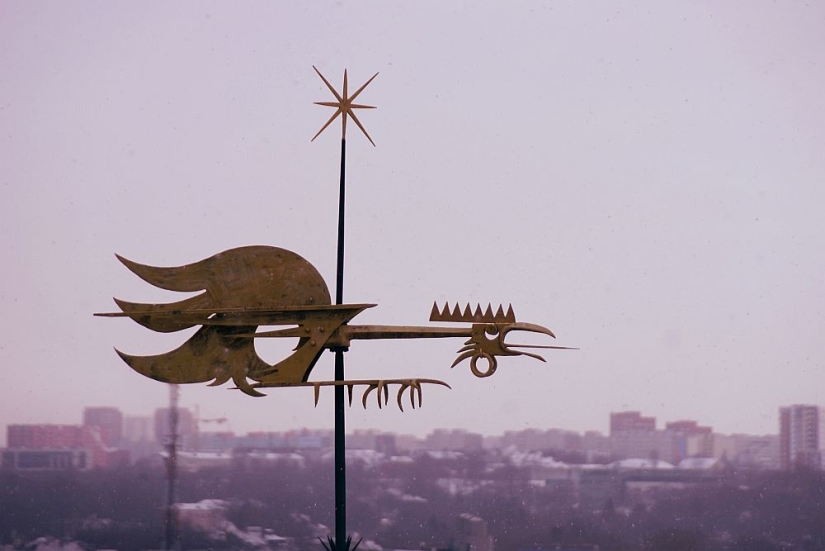How did the weather vane appear and what tasks did it perform in different eras?
Categories: Culture | Design and Architecture | History
By Pictolic https://pictolic.com/article/how-did-the-weather-vane-appear-and-what-tasks-did-it-perform-in-different-eras.htmlWeather vanes installed on roofs indicate the direction of the wind and play the role of decoration. They appeared a long time ago, and their name comes from the Old English word “fana” - banner. Today there are many ways to accurately find out the direction and speed of the wind, but weather vanes, as before, decorate many houses, including modern ones. It turns out that in ancient times this element was not just a primitive meteorological instrument.

Many people believe that weather vanes are a medieval invention. But this is not so, and they appeared in Ancient Greece. The first weather vane is mentioned in sources describing the events of 48 BC. It was made in the form of a figure of the ancient Greek god Triton and was located on the 12-meter Tower of the Winds in Athens, built in the 1st century BC. e.

The Tower of the Winds was erected by the famous astronomer Andronikos of Cyrrhus. It has 8 faces, each of which symbolizes one of the 8 winds: Nota (south), Skirona (northwest), Evra (southeast), Boreas (north), Lipsa (southwest), Apeliota (east), Zephyra (eastern), as well as Kekiya (northeastern).

Unfortunately, the first weather vane has not survived, although the tower still stands. Historians suggest that it was made of copper and reached sizes from 1.5 to 4 meters. There may have been other Greek weather vanes, but, alas, there is no information about them. In the Middle Ages, weather vanes were mentioned around the 9th century. The Vikings used them on their longships. Weather vanes were made of gilded bronze in the form of a cat, dragon or other fantastic creature. The Scandinavians fixed the weather vane on the bow of the ship or on a special pole on the deck.
With the advent of Christianity, the custom arose of bringing weather vanes as gifts to churches, celebrating successful military campaigns. Therefore, weather vanes began to appear on the ridges of Scandinavian churches next to crosses.

The most popular were weather vanes in the shape of a rooster. This bird was not chosen by chance. In the 9th century, the Pope issued a decree according to which roosters were to be installed on churches. They symbolized the Apostle Peter and the entire Catholic Church. This is due to the words of Christ:

The famous 11th century Bayeux Tapestry shows a scene of a weather vane being installed on the spire of Westminster Abbey. This is a real event that the creators of precious embroidery have preserved for posterity.
Later, a pike with a thin metal flag began to be installed not only on temples. They appeared on castle towers, residential buildings, city halls and other buildings. The heraldic symbols of the owner were placed on the weather vanes decorating the roofs of castles and fortresses. Public buildings could bear the city's coat of arms or the image of its patron saint. Private houses were decorated with weathervanes with the coats of arms of the guilds and classes to which their owners belonged.

In the Middle Ages, the roofs of cities were decorated with hundreds of weather vanes of various types and sizes. These objects were attributed mystical significance. Many believed that they protected against evil spirits and brought happiness and good luck into their homes. If a weather vane broke due to bad weather or fell apart due to disrepair, it was considered a bad omen and they tried to restore it as quickly as possible.

But, oddly enough, the peak of fashion for weathervanes occurred in... the Victorian era. The demand for them was so great that entire factories were opened in England to produce these decorative elements. At the beginning of the 20th century, the fashion for weather vanes gradually died out. But in the 70s it flared up with renewed vigor and continues to this day.
Recent articles

A year before Madonna first appeared on television and confidently told American Bandstand host Dick Clark that she was going to ...

In a recent issue of sexual harassment on everyone's lips. Inappropriate and Intrusive signs of attention began to see around, even ...

At first glance, it was an ordinary wedding, and even the priest of the San Jorge Church did not notice anything strange. But in ...